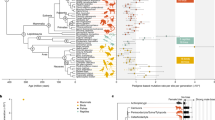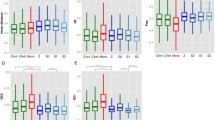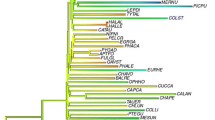Abstract
In mammals, males undergo a greater number of germline cell divisions compared with females. Thus, the male germline accumulates more DNA replication errors, which result in male mutation bias—a higher mutation rate for males than for females. The phenomenon of male mutation bias has been investigated mostly for rodents and primates, however, it has not been studied in detail for other mammalian orders. Here we sequenced and analyzed five introns of three genes (DBX/DBY, UTX/UTY, and ZFX/ZFY) homologous between X and Y chromosomes in several species of perissodactyls (horses and rhinos) and of primates. Male mutation bias was evident: substitution rate was higher for a Y chromosome intron than for its X chromosome homologue for all five intron pairs studied. Substitution rates varied regionally among introns sequenced on the same chromosome and this variation influenced male mutation bias inferred from each intron pair. Interestingly, we observed a positive correlation in substitution rates between homologous X and homologous Y introns as well as between orthologous primate and perissodactyl introns. The male-to-female mutation rate ratio estimated from concatenated sequences of five perissodactyl introns was 3.88 (95% CI = 2.90–6.07). Using the data generated here and estimates available in the literature, we compared male mutation bias among several mammalian orders. We conclude that male mutation bias is significantly higher for organisms with long generation times (primates, perissodactyls, and felids) than for organisms with short generation times (e.g., rodents) since the former undergo a greater number of male germline cell divisions.


Similar content being viewed by others
References
Bartosch-Harlid A, Berlin S, Smith NG, Moller AP, Ellegren H (2003) Life history and the male mutation bias. Evol Int J Org Evol 57:2398–2406
Chang BH, Li WH (1995) Estimating the intensity of male-driven evolution in rodents by using X-linked and Y-linked Ube 1 genes and pseudogenes. J Mol Evol 40:70–77
Chang BH, Shimmin LC, Shyue SK, Hewett-Emmett D, Li WH (1994) Weak male-driven molecular evolution in rodents. Proc Natl Acad Sci USA 91:827–831
Ellegren H, Fridolfsson AK (1997) Male-driven evolution of DNA sequences in birds. Nat Genet 17:182–184
Ellegren H, Fridolfsson AK (2003) Sex-specific mutation rates in salmonid fish. J Mol Evol 56:458–463
Filatov DA, Charlesworth D (2002) Substitution rates in the X- and Y-linked genes of the plants, Silene latifolia and S. dioica. Mol Biol Evol 19:898–907
Gaffney DJ, Keightley PD (2005) The scale of mutational variation in the murid genome. Genome Res 15:1086–1094
Gibbs RA, Weinstock GM, Metzker ML, et al. (2004) Genome sequence of the Brown Norway rat yields insights into mammalian evolution. Nature 428:493–521
Goodman M, Grossman LI, Wildman DE (2005) Moving primate genomics beyond the chimpanzee genome. Trends Genet 21:511–517
Hardison RC, Roskin KM, Yang S, Diekhans M, Kent WJ, Weber R, Elnitski L, Li J, O’Connor M, Kolbe D, Schwartz S, Furey TS, Whelan S, Goldman N, Smit A, Miller W, Chiaromonte F, Haussler D (2003) Covariation in frequencies of substitution, deletion, transposition, and recombination during eutherian evolution. Genome Res 13:13–26
Hellborg L, Ellegren H (2003) Y chromosome conserved anchored tagged sequences (YCATS) for the analysis of mammalian male-specific DNA. Mol Ecol 12:283–291
Hellmann I, Prufer K, Ji H, Zody MC, Paabo S, Ptak SE (2005) Why do human diversity levels vary at a megabase scale? Genome Res 15:1222–1231
Huang W, Chang BH, Gu X, Hewett-Emmett D, Li W (1997) Sex differences in mutation rate in higher primates estimated from AMG intron sequences. J Mol Evol 44:463–465
Kumar S, Tamura K, Nei M (2004) MEGA3: Integrated software for Molecular Evolutionary Genetics Analysis and sequence alignment. Brief Bioinform 5:150–163
Lahn BT, Page DC (1999) Four evolutionary strata on the human X chromosome. Science 286:964–967
Laird CD, McConaughy BL, McCarthy BJ (1969) Rate of fixation of nucleotide substitutions in evolution. Nature 224:149–154
Lawson LJ, Hewitt GM (2002) Comparison of substitution rates in ZFX and ZFY introns of sheep and goat related species supports the hypothesis of male-biased mutation rates. J Mol Evol 54:54–61
Lercher MJ, Williams EJ, Hurst LD (2001) Local similarity in evolutionary rates extends over whole chromosomes in human-rodent and mouse-rat comparisons: implications for understanding the mechanistic basis of the male mutation bias. Mol Biol Evol 18:2032–2039
Li WH (1977) Distribution of nucleotide differences between two randomly chosen cistrons in a finite population. Genetics 85:331–337
Li WH, Yi S, Makova K (2002) Male-driven evolution. Curr Opin Genet Dev 12:650–656
Makova KD, Li WH (2002) Strong male-driven evolution of DNA sequences in humans and apes. Nature 416:624–626
Makova KD, Patton JC (1998) Increased yield of tri- and tetranucleotide heterospecific microsatellites from unenriched small-insert libraries. Biotechniques 24:38, 40, 42–43
Makova KD, Yang S, Chiaromonte F (2004) Insertions and deletions are male biased too: a whole-genome analysis in rodents. Genome Res 14:567–573
Miyata T, Hayashida H, Kuma K, Mitsuyasu K, Yasunaga T (1987) Male-driven molecular evolution: a model and nucleotide sequence analysis. Cold Spring Harb Symp Quant Biol 52:863–867
Norman JE, Ashley MV (2000) Phylogenetics of Perissodactyla and tests of the molecular clock. J Mol Evol 50:11–21
Nowak RM (1991) Walker’s mammals of the world. John Hopkins University Press, Baltimore
Oakenfull EA, Clegg JB (1998) Phylogenetic relationships within the genus Equus and the evolution of alpha and theta globin genes. J Mol Evol 47:772–783
Pecon Slattery J, O’Brien SJ (1998) Patterns of Y and X chromosome DNA sequence divergence during the Felidae radiation. Genetics 148:1245–1255
Ptak SE, Roeder AD, Stephens M, Gilad Y, Paabo S, Przeworski M (2004) Absence of the TAP2 human recombination hotspot in chimpanzees. PLoS Biol 2:849–855
Raudsepp T, Kata SR, Piumi F, Swinburne J, Womack JE, Skow LC, Chowdhary BP (2002) Conservation of gene order between horse and human X chromosomes as evidenced through radiation hybrid mapping. Genomics 79:451–457
Raudsepp T, Santani A, Wallner B, Kata SR, Ren C, Zhang HB, Womack JE, Skow LC, Chowdhary BP (2004) A detailed physical map of the horse Y chromosome. Proc Natl Acad Sci USA 101:9321–9326
Saitou N, Nei M (1987) The neighbor-joining method: a new method for reconstructing phylogenetic trees. Mol Biol Evol 4:406–425
Shimmin LC, Chang BH, Li WH (1993) Male-driven evolution of DNA sequences. Nature 362:745–747
Skaletsky H, Kuroda-Kawaguchi T, Minx PJ, Cordum HS, Hillier L, Brown LG, Repping S, Pyntikova T, Ali J, Bieri T, Chinwalla A, Delehaunty A, Delehaunty K, Du H, Fewell G, Fulton L, Fulton R, Graves T, Hou SF, Latrielle P, Leonard S, Mardis E, Maupin R, McPherson J, Miner T, Nash W, Nguyen C, Ozersky P, Pepin K, Rock S, Rohlfing T, Scott K, Schultz B, Strong C, Tin-Wollam A, Yang SP, Waterston RH, Wilson RK, Rozen S, Page DC (2003) The male-specific region of the human Y chromosome is a mosaic of discrete sequence classes. Nature 423:825–837
Springer MS, Murphy WJ, Eizirik E, O’Brien SJ (2003) Placental mammal diversification and the Cretaceous-Tertiary boundary. Proc Natl Acad Sci USA 100:1056–1061
Tamura K, Nei M (1993) Estimation of the number of nucleotide substitutions in the control region of mitochondrial DNA in humans and chimpanzees. Mol Biol Evol 10:512–526
Taylor J, Tyekucheva S, Zody M, Chiaromonte F, Makova KD (2006) Strong and weak male mutation bias at different sites in the primate genomes: insights from the human-chimpanzee comparison. Mol Biol Evol 23:565–573
Thompson JD, Higgins DG, Gibson TJ (1994) CLUSTAL W: improving the sensitivity of progressive multiple sequence alignment through sequence weighting, position-specific gap penalties and weight matrix choice. Nucleic Acids Res 22:4673–4680
Vogel F, Motulsky AG (1997) Human genetics: problems and approaches. Springer, Berlin
Whittle CA, Johnston MO (2002) Male-driven evolution of mitochondrial and chloroplastidial DNA sequences in plants. Mol Biol Evol 19:938–949
Yang Z (1997) PAML: a program package for phylogenetic analysis by maximum likelihood. Comput Appl Biosci 13:555–556
Acknowledgments
We thank Matt Ghent for help in the analysis, Chungoo Park for implementing the permutation test, and Erika Kvikstad for critical reading of the manuscript. The perissodactyl DNA samples were kindly provided by the San Diego Zoological Society. This study was supported by NIH Grant R01-GM072264 and by start-up funds from the Eberly College of Sciences at Penn State University to K.D.M.
Author information
Authors and Affiliations
Corresponding author
Additional information
[Reviewing Editor: Dr. Deborah Charlesworth]
Electronic Supplementary Material
Rights and permissions
About this article
Cite this article
Goetting-Minesky, M.P., Makova, K.D. Mammalian Male Mutation Bias: Impacts of Generation Time and Regional Variation in Substitution Rates. J Mol Evol 63, 537–544 (2006). https://doi.org/10.1007/s00239-005-0308-8
Received:
Accepted:
Published:
Issue Date:
DOI: https://doi.org/10.1007/s00239-005-0308-8




